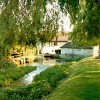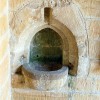Artistic talent in 18th century England has been said to have-lagged some way behind the standard of painters in the rest of Europe, where talent appears to have been thicker on the ground. It was considered that landscape painting was an unworthy subject for an artist to indulge. So Dorset can proudly claim to number among its sons a luminary in the art world who applied his talent to great commissions, and who would become the first English artist to be knighted.
This son of Dorset was James Thornhill. The family name derived from the then hamlet of that name in the northern parish of Stalbridge, today a part of that town. His earliest traceable ancestor was Lord of the Manor at the time of Richard II, and the Thornhills held the manor until the late 17th century. Some uncertainty exists as to whether James was born in 1675 or 1676, but his birthplace was Melcombe Regis, Weymouth. His father was Walter Thornhill of Wareham, a grocer who was the eighth of sixteen children; his mother Mary was the daughter of the Governor of Wareham, Col William Sydenham. While James was still young, his father abandoned his children, leaving James in the care of his uncle, Dr Sydenham.
James’ rare talent showed itself early and in 1689 when he was 14 he was apprenticed to Thomas Highmore, to whom he was distantly related. Highmore was then Sergeant-Painter to William III, and specialised in non-figurative work. Thornhill soon found himself assisting his master with the interior décor at Chatsworth House, and during his work there was introduced to the work of the French and Italian masters such as Laguere, Cheron and Verrio, who greatly inspired the novice.
In March 1704, eight years after completing his apprenticeship, Thornhill was made a Freeman of the Painter-Stainers Company of London. In 1707 he began work at the Royal Navy Hospital (now Greenwich College,) a commission which would preoccupy him on and off for almost two decades. Justifiably considered his masterpiece, this involved two lofty ceilings and five murals depicting the protestant succession from William and Mary to George I. The Painted Hall alone was 108 feet by 50 feet, and took four years to complete.
Following a visit to the continent in the early 1700’s Thornhill was appointed Sergeant-Painter to Queen Anne. In 1711 the painter was appointed a director of Sir Godfret Kneller’s Academy, succeeding him as governor there from 1716 to 1720. He was also active in promoting other early art academies. In 1721, when the Naval Hospital commission was half-finished, George I knighted Sir James Thornhill.
Running concurrently with this mammoth undertaking was another commission (1714-1717) to embellish the dome and Whispering Gallery of St. Paul’s with scenes from the life of that patron apostle in eight guilded chiaroscuro designs. To gain this contract however, Thornhill had to ward off competition from the Italian masters Pellegrini and Ricci. It is noted that during this task he almost lost his life when he stepped too far back on the platform suspended from the dome, but was saved by his assistant’s intervention in pulling him back from certain death.
The years of the Greenwich and St. Paul’s commissions were productive for James Thornhill in other ways too. In the 1720’s he established his own drawing school at Covent Garden, where his pupils would include William Hogarth. By then Sir James had married and had a daughter, Jane, to whom Hogarth eventually became engaged and married, though the father -in-law of the future painter of ‘The Rake’s Progress’ thought his pupil had betrayed his trust, and for a time he cold shouldered the union.
In 1722 Thornhill was contracted to work at Kensington Palace, but over-charged for the job, leaving him open to being under-cut by the ascendant William Kent. Other works of Sir James were painted scenes for the Drury Lane Theatre, the Great Hall at Blenheim, Princesses apartments at Hampton Court, the South Sea Company’s hall and staircase, the staircase at Easton Newton (Northants) and the chapel at Whimpole.
Another plank of Thornhill’s work was to illustrate books and carry out some architectural work, though Moor Park in Hertfordshire is believed to be the only building wholly attributable to him. At one time in this capacity he even drew up plans for the new town hall at Blandford. He further undertook some portrait painting, Sir Isaac Newton and the play-write Sir Richard Steele being two of his most illustrious subjects. His smaller works from the easel include the altar pieces for Queens College and All Souls Chapels in Oxford, and even an altar piece portraying the Last Supper for St. Mary’s Church in his home territory of Melcombe Regis.
St. Mary’s however, was not the only work of Thornhill’s hand to grace some of the stately homes in his native county. In total he pained four murals for Dorset Houses, but only two of these – at Sherborne and Charborough – survive. That at Sherborne is on the theme of the Caledonian Hunt, and shows the goddess Diana gazing down from the ceiling. This painting however, is in urgent need of restoration, but requires £55,000 to be raised in order for the work to be carried out.
James Thornhill’s life work earned him honours, wide acclaim and – for the time – a great fortune. For example the Greenwich naval hospital commission alone netted him over £6,000 – three times the earnings of an 18th century Dorset farm labourer over his entire working life. At Greenwich he commanded the fee rate of £1 per square yard for the walls and £3 per square yard for the ceiling.
As well as his knighthood, Thornhill became a Fellow of the Royal Society in 1723 and in 1722 was elected MP for Melcombe Regis and Weymouth. This had recently been the constituency of Sir Christopher Wren and Thornhill held it for the next 12 years, though it is not thought that he ever made a speech in the Commons throughout all this time. He did however, paint the houses of Parliament (as they then were) in 1730, a work in which he was assisted by his son-in-law William Hogarth, and which has been in the possession of the Earl of Hardwicke.
But following his work at Moor Park Thornhill undertook no further major commissions. He hardly needed to. With the great wealth he had accrued, Sir James was able in 1725 to re-purchase his ancestral seat at Stalbridge. Here he built Thornhill House in the Palladian style, setting up in the grounds a lofty obelisk to commemorate the accession of George II. And after several years of genteel retirement in broken health marked by attacks of gout, Sir James Thornhill died here on May 4th 1734 aged about 60.



